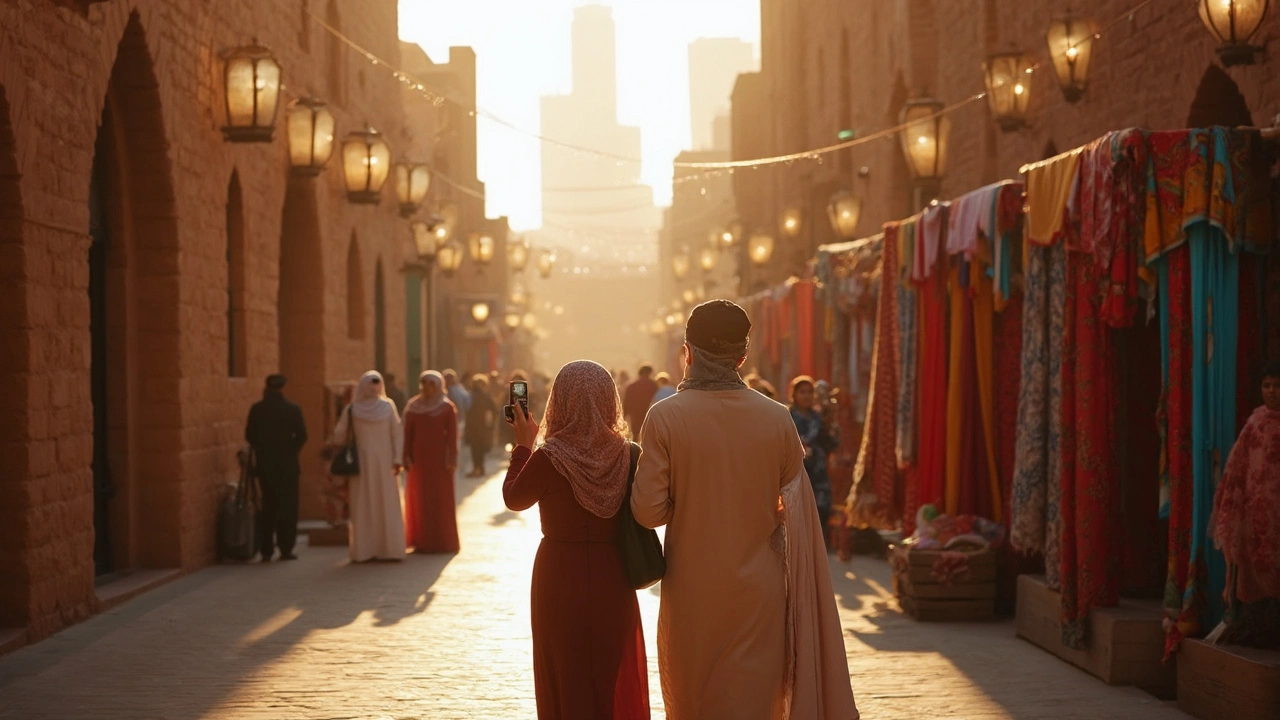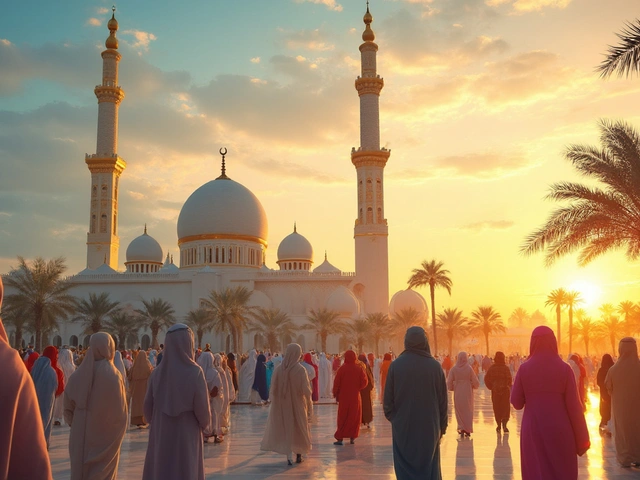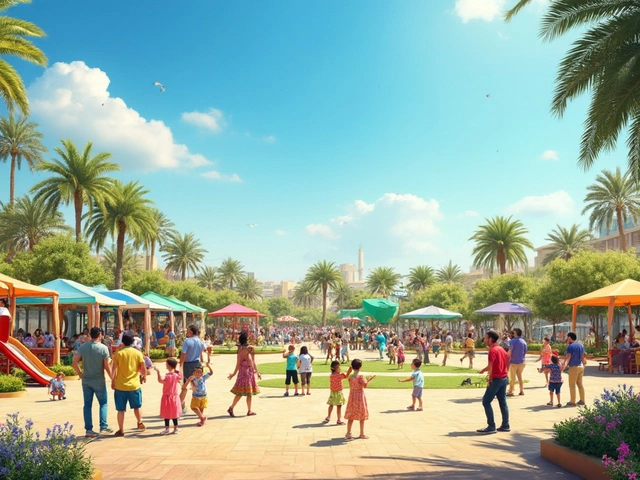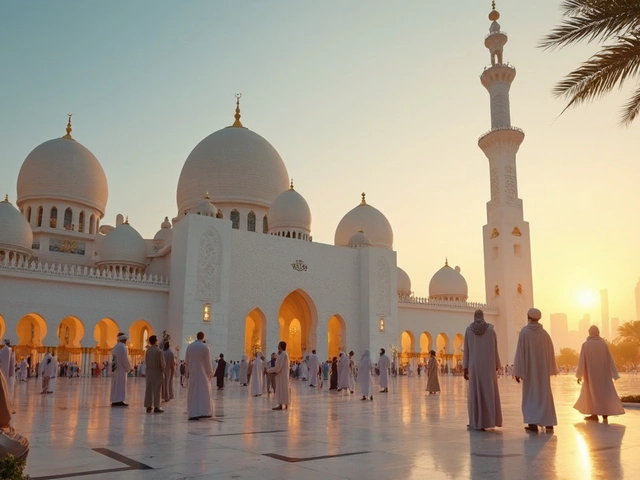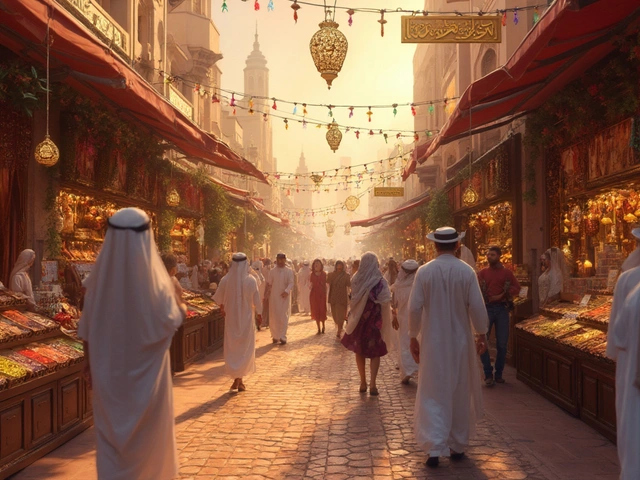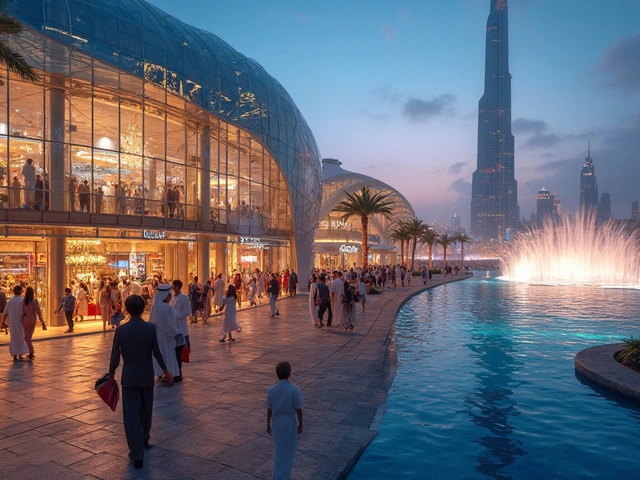Ever felt that Dubai’s skyscrapers have stolen the spotlight from its older gems? Turns out, some of the city’s most unforgettable photos come from places grounded in history—not steel and glass. Al Fahidi Historical Neighborhood, for example, is less than 20 minutes from Downtown Dubai, but stepping onto its narrow lanes feels like you’re somewhere else entirely.
You’ll want to go early in the morning or after 4pm to dodge the tourist crowds. Most of the wind tower houses have sand-colored facades and wooden doors, making every backdrop unique. If you’re worried about dress codes, just stick to modest clothing—long pants and covered shoulders—and you’ll have zero problems blending in.
Pretty much everyone in Dubai knows that the creek divides old and new, so shots with the traditional abras—or water taxis—cruising by capture that perfect city contrast. Pro tip: Friday mornings are quieter, and you might snag an angle with just locals heading to the spice market. Oh, and keep your camera ready for the cool art murals in XVA Gallery—they’re all about real Emirati heritage.
- Old Dubai’s Al Fahidi District
- The Gold and Spice Souks
- Al Seef: Where Heritage Meets the Creek
- Jumeirah Mosque Photo Spots
- Hidden Gems Beyond Downtown
- Tips for Shooting Historical Dubai
Old Dubai’s Al Fahidi District
If you want shots that feel classic Dubai, you can’t skip Al Fahidi District. This pocket of the city has survived since the late 19th century—crazy, right? Back then, it was full of merchants and traders. Now, it’s where you’ll find those famous wind tower houses and sand-colored walls that basically scream history.
Today, over 50 restored buildings line the narrow alleys, and many are open to the public. There’s the Dubai Museum (in the old Al Fahidi Fort), but also art spaces like Majlis Gallery and XVA Gallery where you can snap something a bit different. Don’t be surprised if you see local artists setting up in the courtyards—it’s normal, and most won’t mind if you politely ask for a photo.
If Instagram’s your goal, the light is your best friend between 7 am and 9 am. The district gets busy after 10, so aim for an early start, especially on weekends. Stick to the shaded lanes for softer photos and less glare—Dubai’s sun does not play around.
- Entry is free: you can wander pretty much everywhere without tickets.
- Cafes like Arabian Tea House have colorful tiled courtyards perfect for snaps (and refreshments).
- Visit during Sikka Art Fair (usually in March) for vibrant murals and cool installations that only happen once a year.
- Modest dress helps you blend in and shows respect for Emirati customs.
For a quick comparison, here’s what you can expect from the district:
| Feature | Quick Take |
|---|---|
| Entry Cost | Free |
| Best Time for Photos | 7–9 am, after 4 pm |
| Dress Code | Modest (cover shoulders/knees) |
| Top Instagram Spot | Arabian Tea House Courtyard |
| Closest Metro | Al Fahidi Station (5 min walk) |
If you’re serious about showing off Dubai historical sites (and not just the fancy hotels), make Al Fahidi District your first stop. And bring comfy shoes—you’ll hit 5,000 steps in no time roaming those lanes.
The Gold and Spice Souks
If you’ve seen those shimmering photos of Dubai’s Deira, you know the Dubai historical sites vibe is strongest in the Gold and Spice Souks. These markets have been here for decades—long before the malls and the Burj Khalifa. The Gold Souk is legendary; rumor says there’s usually over 10 tons of gold available at any time. If you want a photo that screams “authentic Dubai” while catching some bling, this is your spot.
Cameras are welcome here, but you’ll want to ask first if you’re snapping specific vendors or their displays. The souks really come to life between 10am and 1pm or after 4pm when the sun throws a golden hue over the narrow alleys. Beware Fridays though—most shops open only late afternoon.
- Wear comfy shoes: the ground’s uneven, and there’s a lot to explore.
- Bargaining is normal, and shopkeepers expect it—don’t be shy about negotiating prices or even a smile as you snap pics.
- No need for guided tours—everything’s crammed together, so you won’t get lost.
- Don’t eat or drink openly during Ramadan daylight hours as a sign of respect.
The Gold Souk is famous for the “Najmat Taiba,” officially the world’s largest gold ring, clocking in at over 64 kg. Shoppers (and shutterbugs) can pose right by it—no purchase needed. Head next door to the Spice Souk and get a shot of buckets stacked with saffron, cardamom, and rose petals. Local residents from Deira swear by its affordable, high-quality spices and the colors really boost any Insta grid.
According to the Dubai Department of Economy and Tourism, Deira’s markets get about 2.5 million visitors annually. Translation: come early or late to dodge the rush and get those solo shots.
"Dubai’s souks offer the kind of sensory overload that no modern mall can match. For street photographers, there’s nowhere better in the city to capture real Dubai energy." — Gulf News, May 2023
| Market | Best Photo Times | Famous For | Dress Code |
|---|---|---|---|
| Gold Souk | 10:00–13:00 / 16:00–18:00 | Largest gold ring, gold displays | Modest, covering knees/shoulders |
| Spice Souk | 11:00–12:00 / 17:00–19:00 | Stacks of colorful spices | Modest, light clothing |
Another tip: Take the abra across the creek for just AED 1, so you can snap the souks from the water—skyline and old shopfronts all in one shot. It’s one of those classic Dubai attractions that locals still love.
Al Seef: Where Heritage Meets the Creek
Al Seef sits right along Dubai Creek, just south of the Al Fahidi District, and it’s hands-down one of the best spots for mixing old-school vibes with modern cafes. The area stretches for about 1.8 kilometers, and when you walk here, you’ll notice how the whole place is split into two zones—one looks like a movie set from the 1800s, with narrow alleys and mud-brick buildings, while the other has sleek waterfront restaurants and boutique shops.
You want Instagrammable Dubai? This is it. Even locals who’ve seen Dubai’s glitz love coming here for sunset. The best shots? Capture the traditional dhows bobbing on the water while the wind towers catch golden hour light. Most folks head toward the Old Souk part for authentic vibes, but the newer side gives you epic city-meets-history photos—especially if you frame the twin Heritage hotels with the skyline in the background.
If you want crowd-free pics, weekdays before noon or just after Fajr prayer work best—most shops don’t open until 10am. During Ramadan, the area comes alive after sunset with creekside Iftar tents and lantern-lit walkways (ask at the info center if you’re not sure about timing or etiquette).
- To respect local culture, wear casual but modest clothing. No one expects you to be in an abaya unless you’re visiting a mosque.
- Photography is allowed in public, but always ask permission before snapping shots of people, especially families or shopkeepers.
- Try shots of street art, the mini-museum displays, and Emirati tea stalls—these get tons of shares for their real Dubai feel.
| Feature | Details |
|---|---|
| Length of Al Seef | 1.8 km along Dubai Creek |
| Opening Hours | Most shops: 10am-10pm, Cafes open earlier |
| Nearest Metro | Al Fahidi (Green Line), 10 minutes' walk |
| Instagram Hotspots | Old Souk alleys, Dhow harbor, Creekside walkways |
Don’t miss the floating market events, especially on UAE National Day—boats turn into pop-up shops selling local snacks and crafts. And if you’re hungry, head for Kava & Chai’s terrace or try Saba’a for real Emirati breakfast. If you’ve got guests visiting, Al Seef delivers that classic Dubai mix: a peek into the past, modern treats, and feeds that’ll rack up likes in no time.
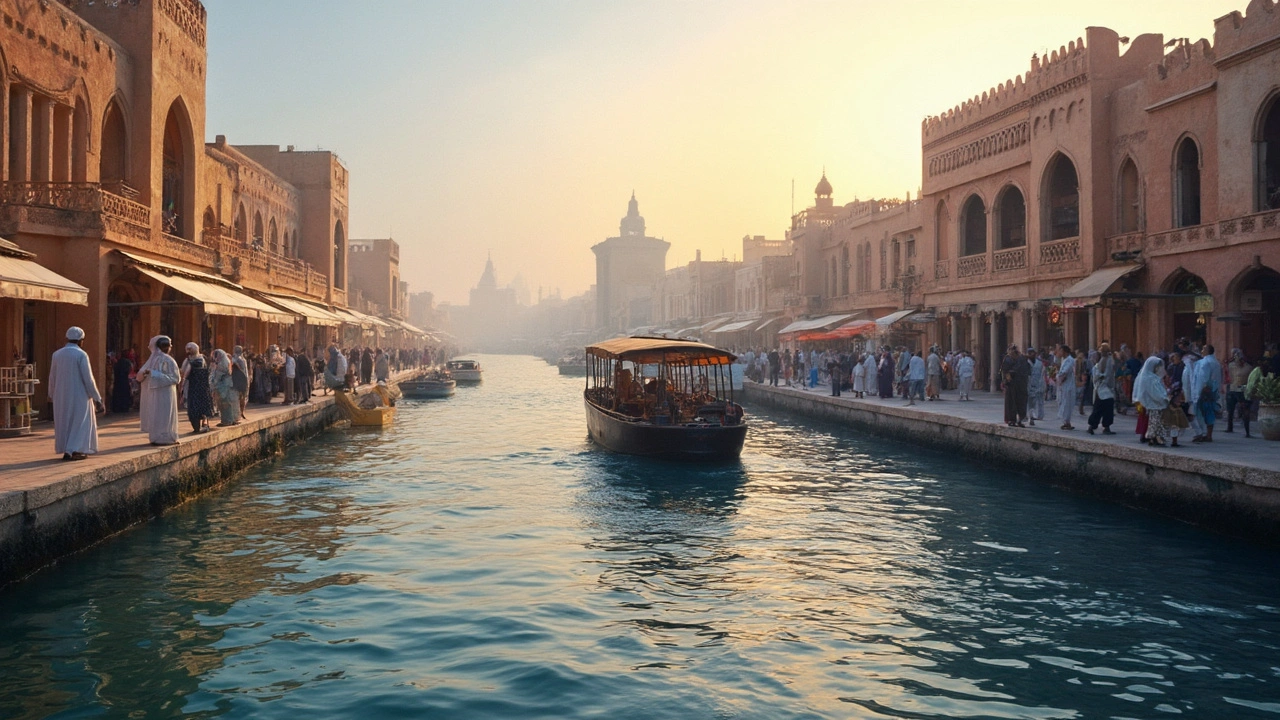
Jumeirah Mosque Photo Spots
Jumeirah Mosque stands out as one of the best places for snapping photos that scream "Dubai." It's also one of the few mosques in the city open to non-Muslims for guided tours, which matters if you want to see the inside, not just the outside. The tours run through the Sheikh Mohammed Centre for Cultural Understanding and start at 10:00 a.m. every day except Friday.
The best time for photos is just after sunrise or at golden hour before sunset. That’s when the light turns the white stone a soft pastel peach, especially if there aren’t any harsh shadows from parked cars. If you want an empty foreground, aim for a weekday morning—weekends get busy with tour groups and everyone trying to get that iconic shot.
There’s a classic angle across Jumeirah Beach Road, especially from the landscaped area just opposite the mosque. You can also get creative with shots along the small garden paths or frame the minarets against the blue sky and nearby palm trees. Just don’t step into the road—traffic there is no joke. If you’re visiting inside during a tour, take a wide lens for the prayer hall. Ask before photographing people praying or inside the main halls, as there are privacy and respect rules here.
Wear modest clothes—long pants or skirts, and sleeves. Women will be given a scarf to borrow at the entrance, but bringing your own saves time. Tripods aren’t usually needed since the sun is so strong, but they’re allowed for outside shots if you don’t block any walkways.
If you post your photos, tag the mosque’s official account or add #JumeirahMosque and #Dubai historical sites to reach more locals and residents keen on cultural spots. This place isn’t just a Dubai historical site; it’s a symbol of the city’s openness. Plus, your followers will eat up the clean lines and the mosque’s chill, calm vibe.
Hidden Gems Beyond Downtown
Most people think the best old-school photo spots are packed into Deira and Bur Dubai, but if you look a bit further, you’ll score unique shots that barely make it onto most Dubai feeds. Head out to the Saruq Al Hadid Archaeology Museum in Al Shindagha. Opened in 2016, this site digs deep into Dubai’s ancient past—literally, since a full-on archaeological dig from the Iron Age was found here in the southern desert. The museum houses over 8,000 artifacts, from jewelry to ceremonial daggers. Photos next to the ancient pottery and tools look wild compared to Dubai Mall selfies.
Another solid choice is Al Marmoom Heritage Village, set up in the desert outskirts. It pops up during the camel racing season, usually December to March. The timing matters: aim for early morning or sunset for softer light. You’ll catch traditional Emirati tents, salt flats, and, if you’re lucky, camels being prepped for the races—there’s no cooler shot for showing Dubai’s deep-rooted culture outside touristy areas. And yes, it’s family-friendly and free to enter during festivals.
Want something only locals talk about? Smash a visit to Hatta Heritage Village. It’s about a 90-minute drive but feels worlds away, surrounded by the Hajar Mountains. The restored watchtowers and mud-brick houses date back to at least the 16th century. Climb up the fort for panoramic views over the old settlement and dam—amazing for ultra-wide angle shots. On weekends, you’ll see residents in full Emirati dress, plus you can catch cultural markets with handmade crafts. Phone reception is spotty, so download your map offline.
If you like quirky history, check out Al Lisaili Camel Market, south of the city. Don’t expect polished walkways, but you’ll get the most authentic feel for Dubai’s trading history. Snapping pics of young camels and chatting with traders makes for killer stories back home.
The difference between these places and more central Dubai historical sites comes down to the crowd count and sheer authenticity. No neon signs, no huge tour bus lines—just raw, local flavor. If you need stats to plan, here’s what you should know:
| Site | Distance from Downtown (km) | Best Time for Photos | Entry Fee |
|---|---|---|---|
| Saruq Al Hadid Museum | 13 | Weekdays, 10am-12pm | AED 20 |
| Al Marmoom Heritage Village | 35 | Sunrise/Sunset (Dec-Mar) | Free (during events) |
| Hatta Heritage Village | 110 | Late afternoon | Free |
| Al Lisaili Camel Market | 38 | Early morning | Free |
If you’re after unique posts, aim for weekday visits and use public transport when you can—Dubai’s RTA Bus catches Hatta, and taxis cover everywhere else. Just remember, some of these gems run on cash only, especially during events, so bring a few dirhams along.
Tips for Shooting Historical Dubai
If you want those head-turning shots from Dubai historical sites, it pays to do a bit of planning. Dubai's old neighborhoods look best in natural light, so timing matters. Early morning or late afternoon is your best bet because that's when the sun is soft and colors pop without harsh shadows. Summer days can reach over 40°C, so if you’re heading out between June and September, pack water and keep your gear cool.
Tripods are okay in places like Al Fahidi, but leave the drones at home—Dubai has strict rules around flying them, especially near any government or historical building. Security may stop you if you try to stretch the rules. At sites like Jumeirah Mosque, photography is allowed, but always ask before snapping locals, especially women, to respect privacy and customs.
- Dress modestly—not just for cultural respect, but also to blend in, so people don’t get weirded out by your photoshoots.
- Try wide-angle lenses to capture the maze-like alleys and close-up details on old wooden doors.
- Pack a small microfiber cloth—sand and dust can get everywhere, especially if you're switching lenses outdoors.
- If you want empty alleys, Fridays before noon and weekdays before 9am are magic hours.
- Editing apps like Lightroom or Snapseed will help bring out the earthy tones of Dubai’s old brick and stone, but go easy—overly saturated shots just look fake.
For anyone who loves stats, here’s a quick breakdown of the best hours to shoot at Dubai’s major historical sites—based on crowd density and sunlight throughout the year:
| Site | Optimal Time | Best Day | Crowd Level (1-5) |
|---|---|---|---|
| Al Fahidi District | 7:00–9:00am | Friday | 1 |
| Gold & Spice Souks | 8:30–10:30am | Sunday | 2 |
| Jumeirah Mosque | 4:00–6:00pm | Monday | 2 |
| Al Seef | 5:00–7:00pm | Tuesday | 3 |
Don’t forget to check for local events or government holidays; they can make quiet places busy in a flash. And if you’re posting those shots on Instagram, tag the location accurately—Dubai’s community is proud of these sites and loves seeing them framed through a new lens.

